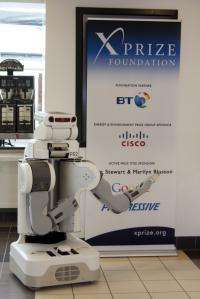(PhysOrg.com) -- The final list of competitors for the robotic Moon explorer prize has been announced. The Google Lunar X first prize total of $20 million will be awarded to the team that is first to transmit high-definition video back from the Moon as its robot travels across at least 500 meters of the Moon’s surface.
The competition was first announced in September 2007 by the X Prize Foundation and sponsor Google. Now the final list of competitors has been announced and includes 29 teams from around the world, ranging from non-profit and university groups to large and well-funded business teams.
The winning team will need to complete its mission before December 31, 2015 to win the $20 million first prize ($15 million if the winning team is a government agency). Other prizes will be awarded for feats such as surviving the freezing lunar night or traveling five kilometers, for finding water, touching down near an Apollo landing site, and for “stimulating diversity” in space exploration.
Plans to transport the robotic vehicles to the Moon include US government-backed space agencies, private US agencies such as SpaceX, a company set up by Elon Musk, the founder of PayPal, and agencies in Russia, China, and elsewhere.
Teams include Astrobotic Technnology, Next Giant Leap, Part-Time Scientists, Mystical Moon, Penn State Lunar Lions, Space II of Israel, Puli of Hungary, and teams from Canada, the Isle of Man, Italy, Romania, Brazil, Chile, Denmark, Malaysia, the Netherlands, India, Spain, and Germany.
Tim Pickens, a propulsion engineer and leader of the US-based Rocket City Space Pioneers team, said the Google Lunar X Prize (GLXP) is not a great concern as it would not cover the mission costs, but he said the first prize would be an “awesome consolation” and a good way to recoup the costs of development.
X Prize Foundation’s senior director William Pomerantz said the goal of the competition is to trigger business of much larger value than the prize, and said that the flags and footprints planted on the Moon so far are not a financially sustainable form of lunar exploration. Recent surveys have shown that valuable resources for moon bases and rockets, such as ammonia, methane and water, are available on the Moon’s surface. There is also hope a rare isotope of helium capable of fuelling fusion reactors may also be present.
Organizers of the competition hope the contest will boost the prospects for lower-cost exploration using robots, and believe privately funded agencies will dominate in future space exploration.
More information: xprize.org/press-release/googl … 30-million-race-moon
© 2010 PhysOrg.com



















